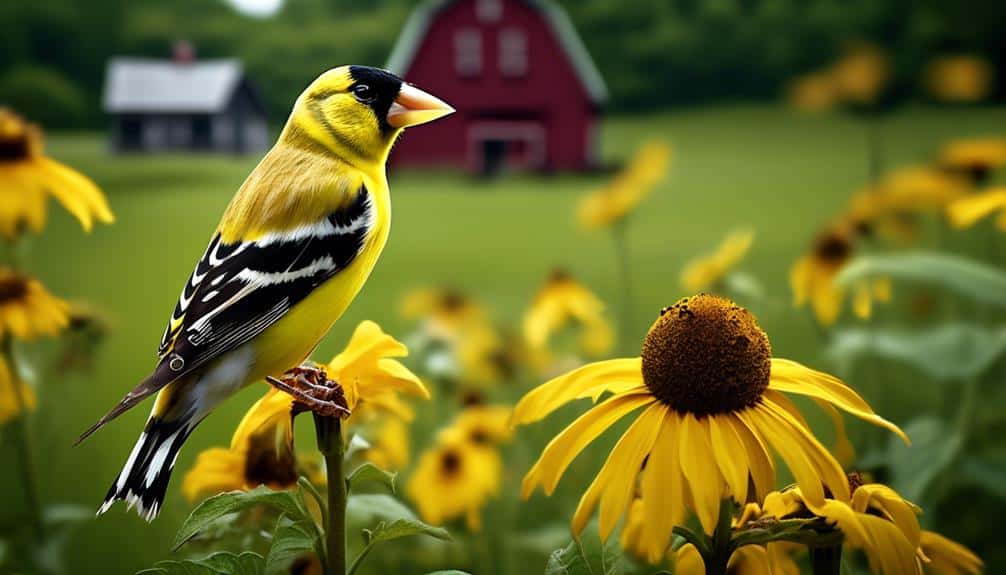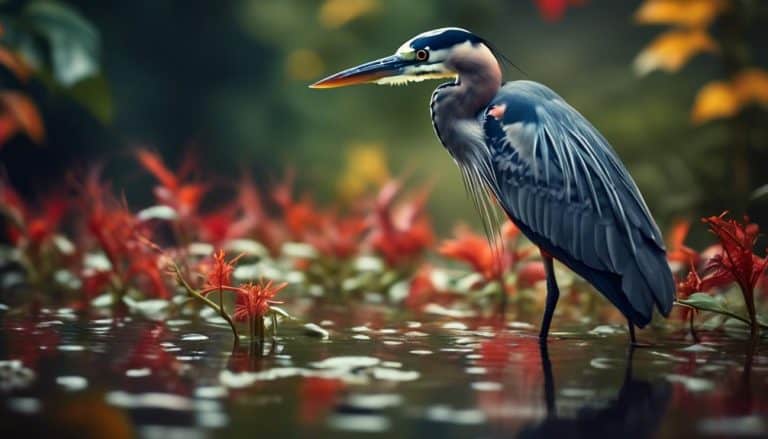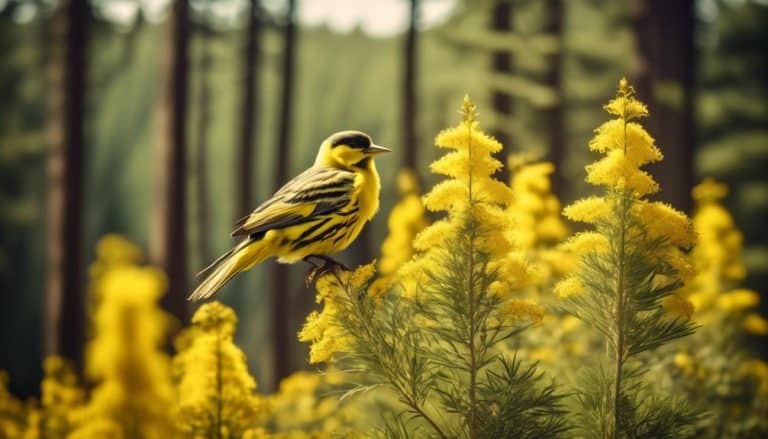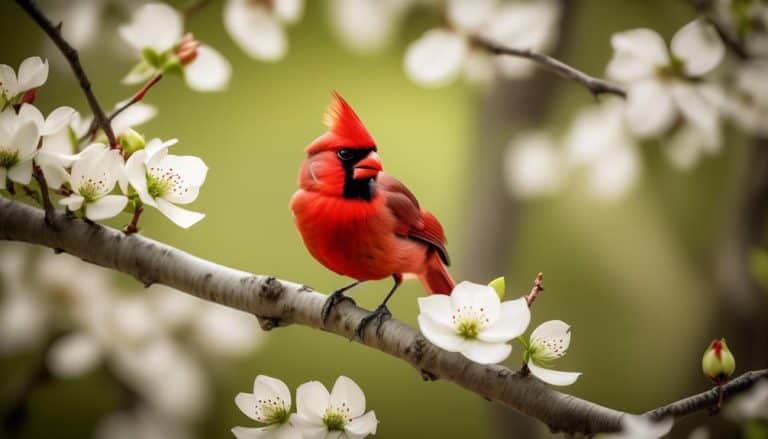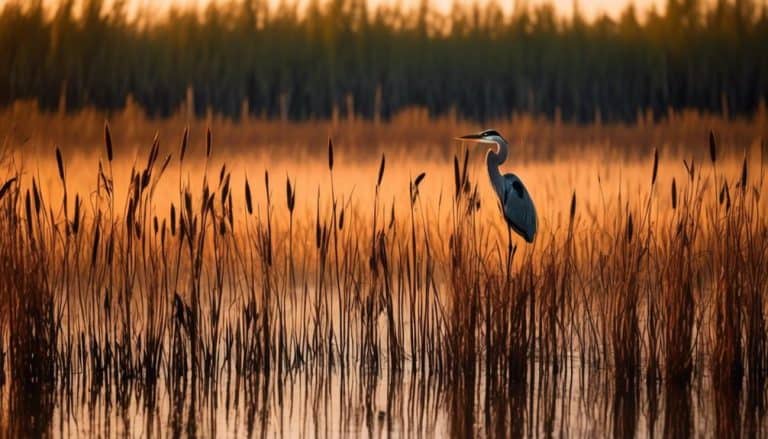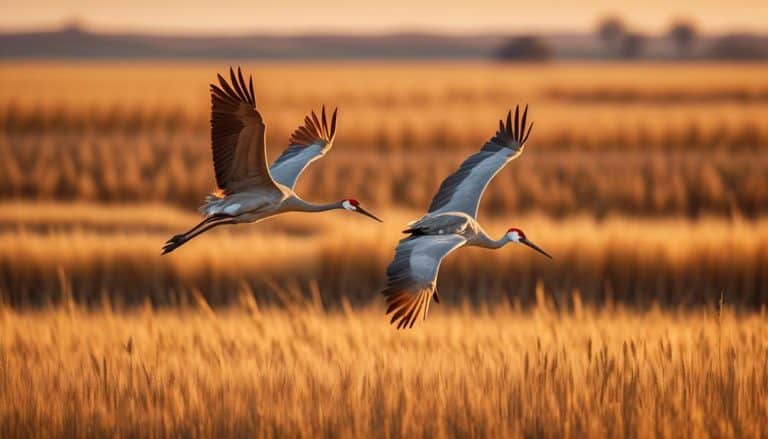Driving through the scenic landscapes of Massachusetts, one can't help but be struck by the vibrant colors that adorn the trees and fields. But amidst the tapestry of autumnal hues, there is a subtle yet captivating sight that often goes unnoticed – the yellow birds.
These feathered creatures, with their sunny plumage and melodic songs, add a touch of warmth to the cool New England air. However, there is much more to these yellow birds than meets the eye.
In this discussion, we will explore their habitat, unique characteristics, behavior, and conservation efforts, shedding light on the hidden world of these captivating creatures.
Common Yellow Birds in Massachusetts
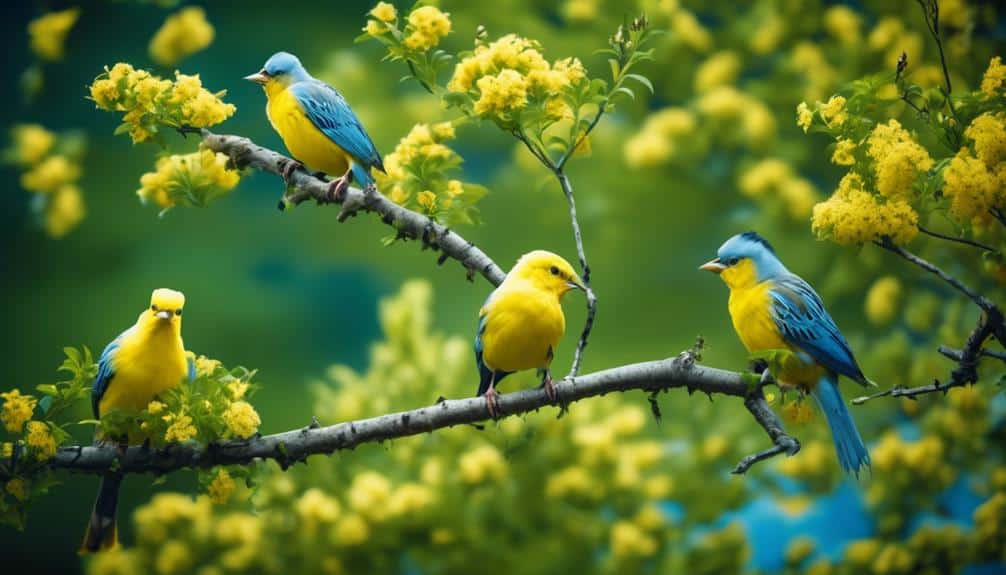
I have observed that there are several species of common yellow birds found in Massachusetts.
As an avid bird watcher and bird photographer, I've had the opportunity to capture stunning images of these vibrant creatures in their natural habitats.
One of the most common yellow birds in Massachusetts is the American Goldfinch (Spinus tristis). This small songbird is easily recognizable with its bright yellow plumage and black wings. They can often be spotted in fields, meadows, and gardens, where they feed on seeds from various plants.
Another common yellow bird in Massachusetts is the Yellow Warbler (Setophaga petechia). This beautiful bird is known for its bright yellow coloration, which is most prominent in the males. They can be found in wetland areas, such as marshes and swamps, where they build their nests and feed on insects.
Lastly, the Common Yellowthroat (Geothlypis trichas) is another species of yellow bird that can be found in Massachusetts. These small, secretive birds are often heard before they're seen, as they sing their distinct 'witchety-witchety-witchety' song. They can be found in marshes and thickets, where they forage for insects and spiders.
Habitat and Distribution of Yellow Birds
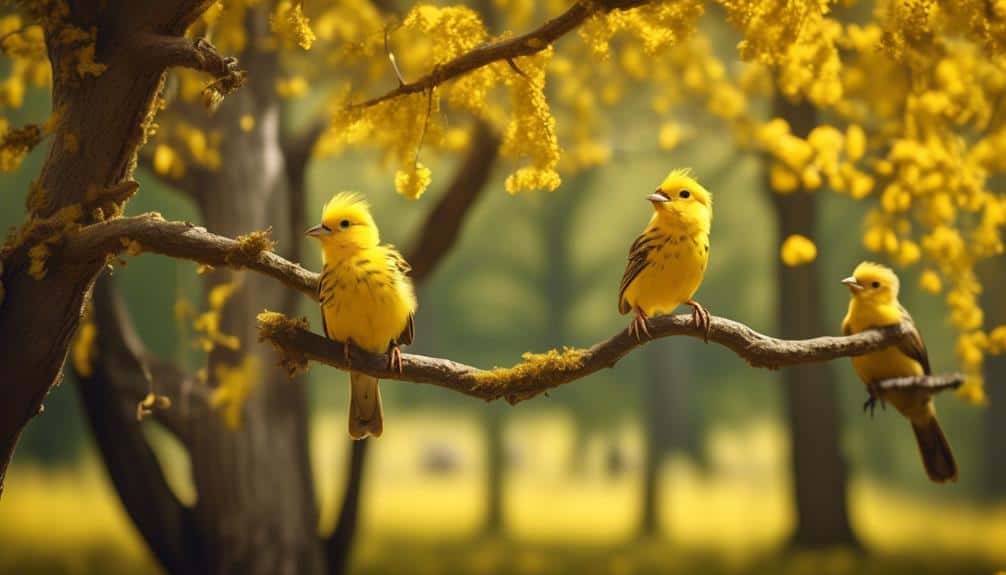
The habitat and distribution of yellow birds in Massachusetts play a crucial role in shaping the presence and abundance of these vibrant avian species. Understanding their habitat requirements and the factors influencing their distribution is essential for effective conservation efforts. Here are four key points to consider:
- Habitat Preferences: Yellow birds in Massachusetts are primarily found in open habitats such as meadows, fields, and shrublands. These areas provide suitable nesting sites, abundant food sources, and perching locations for these species.
- Species Identification: Massachusetts is home to several yellow bird species, including the American Goldfinch, Yellow Warbler, and Eastern Meadowlark. Each species has distinct physical characteristics, vocalizations, and behaviors, which aid in their identification and monitoring.
- Seasonal Distribution: Yellow birds exhibit seasonal movements, with some species being resident year-round and others migrating to and from Massachusetts. These movements are influenced by factors such as food availability, breeding requirements, and weather conditions.
- Threats to Population: The yellow bird population in Massachusetts faces various threats, including habitat loss due to urbanization and agricultural intensification. Other significant challenges include climate change, pollution, and predation. Conservation efforts should focus on mitigating these threats and preserving suitable habitats for these species.
Unique Characteristics of Yellow Birds
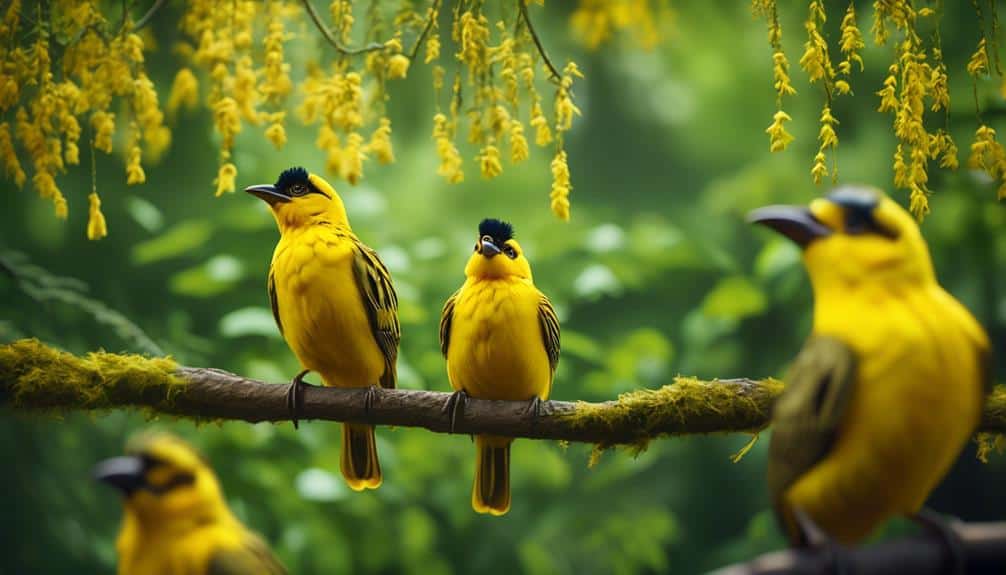
Yellow birds exhibit a variety of unique characteristics that distinguish them from other avian species. One such characteristic is their migration patterns. Yellow birds are known for their long-distance migrations, often traveling thousands of miles between their breeding and wintering grounds. These migrations are driven by the changing seasons and the need to find suitable food and nesting sites. Some species of yellow birds, such as the yellow warbler, migrate from as far north as the Arctic to as far south as South America.
Another distinguishing characteristic of yellow birds is their vocalizations and songs. Yellow birds are known for their melodious and distinctive songs, which they use to communicate with other members of their species. These songs serve a variety of purposes, including attracting mates, defending territories, and warning of potential dangers. Each species of yellow bird has its own unique song, allowing individuals to identify and communicate with others of their kind.
Behavior and Mating Habits of Yellow Birds

Behavior and mating habits of yellow birds are influenced by a combination of instinctual behaviors and environmental factors. Understanding these aspects is crucial to comprehending the life cycle and reproduction of these avian species.
Here are four key insights into the behavior and mating habits of yellow birds:
- Yellow bird migration patterns: Yellow birds are known for their long-distance migratory journeys. They exhibit a remarkable ability to navigate vast distances, relying on a combination of celestial cues, geomagnetic fields, and visual landmarks. Their migrations are usually triggered by changes in daylight, temperature, and food availability.
- Courtship displays: During the mating season, male yellow birds engage in elaborate courtship displays to attract females. These displays often involve vibrant plumage, intricate flight patterns, and melodious songs. The purpose of these displays is to demonstrate the male's fitness and suitability as a mate.
- Vocalizations: Communication plays a vital role in the mating habits of yellow birds. They employ a variety of vocalizations, including songs, calls, and trills, to establish territory, attract mates, and maintain social bonds. Each species has its own unique repertoire of vocalizations.
- Pair bonding: Once a male and female yellow bird form a pair bond, they engage in mutual grooming, territory defense, and nest-building activities. This bond is essential for successful reproduction and raising offspring.
Understanding the behavior and mating habits of yellow birds provides valuable insights into their ecology and conservation. Further research into these aspects can contribute to the preservation of these beautiful avian species.
Conservation Efforts for Yellow Birds in Massachusetts
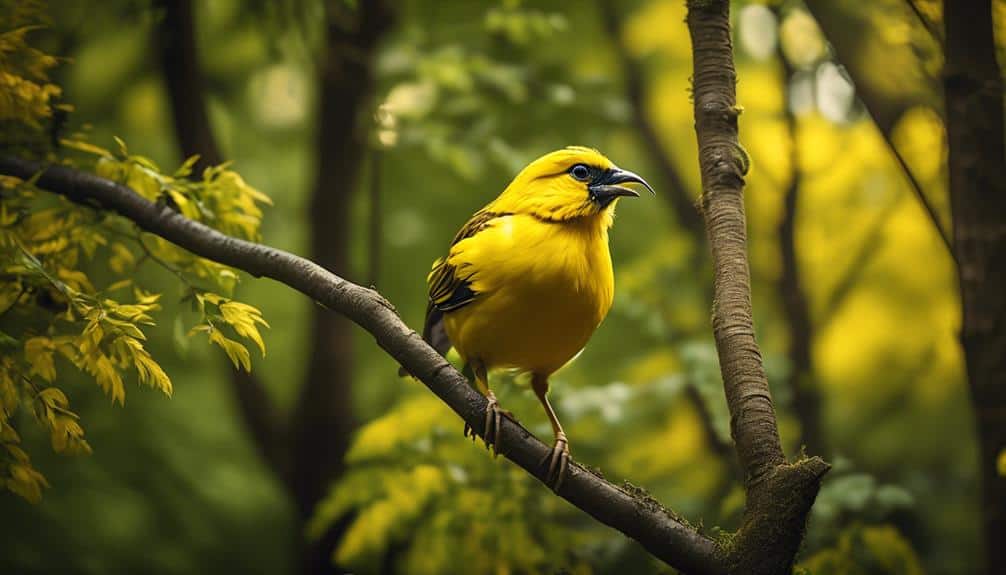
Conservation efforts in Massachusetts focus on protecting and preserving the habitat and population of yellow birds. The population decline of these birds has raised concerns among scientists and conservationists. To combat this decline, various reintroduction programs have been implemented.
One such program is the establishment of protected areas that provide suitable habitats for yellow birds. These areas are carefully managed to ensure the birds have access to food sources, nesting sites, and protection from predators. Additionally, efforts are made to restore and enhance existing habitats to make them more favorable for the birds.
Reintroduction programs play a crucial role in increasing the population of yellow birds. Birds bred in captivity are released into the wild, with the hope that they'll successfully adapt and reproduce. These programs are carefully monitored to assess the success of reintroduction efforts and to gather data on the birds' survival rates and reproductive success.
Conservationists also collaborate with local communities to raise awareness about the importance of yellow bird conservation. Educational campaigns and community engagement initiatives are conducted to promote responsible bird-watching practices and to encourage the public to report any sightings of yellow birds.
Frequently Asked Questions
What Is the Average Lifespan of Yellow Birds in Massachusetts?
The average lifespan of yellow birds in Massachusetts depends on various factors, such as habitat conditions and population threats. It is important to conduct scientific research to gather accurate data on this topic.
Are There Any Specific Threats to the Population of Yellow Birds in Massachusetts?
As for specific threats to the population of yellow birds in Massachusetts, there are several factors that can impact their numbers, such as habitat loss, climate change, and predation. However, conservation efforts are being made to protect and preserve these beautiful creatures.
How Do Yellow Birds Adapt to Different Seasons and Weather Conditions in Massachusetts?
Yellow birds in Massachusetts adapt to different seasons and weather conditions through their foraging habits and plumage variations. They have specific feeding strategies and their feathers change to provide insulation and camouflage.
Do Yellow Birds Migrate to Other Regions During Certain Times of the Year?
Yes, yellow birds do migrate to other regions during certain times of the year. Migratory patterns are influenced by factors such as food availability and climate conditions. However, climate change can disrupt these patterns, affecting the timing and destinations of their migrations.
Are There Any Rare or Endangered Species of Yellow Birds Found in Massachusetts?
Yes, there are rare species of yellow birds found in Massachusetts. Conservation efforts are in place to protect these endangered birds and ensure their survival in the state.
Conclusion
In conclusion, yellow birds in Massachusetts are a common sight due to their wide distribution and adaptable habitat preferences. These birds possess unique characteristics, such as their vibrant yellow plumage and melodious songs.
They exhibit interesting behaviors, including complex mating rituals and strong social bonds. Conservation efforts are crucial to protect these beautiful creatures and ensure their continued presence in the state.
Like a ray of sunshine on a cloudy day, yellow birds bring joy and brightness to the Massachusetts landscape.

